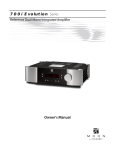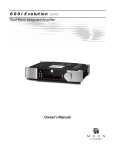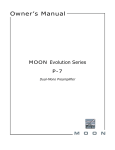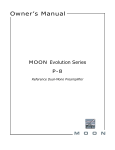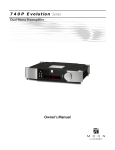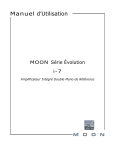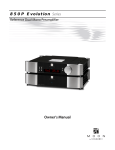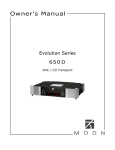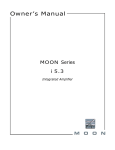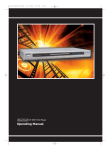Download Simaudio SuperNova CD Player Owner`s manual
Transcript
Owner’s Manual MOON Evolution Series i-7 Reference Dual-Mono Integrated Amplifier MOON i-7 Dual-Mono Integrated Amplifier Important Safety Instructions 1. Read these instructions. 2. Keep these instructions. 3. Heed all warnings. 4. Follow all instructions. 5. Do not use this apparatus near water. 6. Clean only with a dry cloth. 7. Do not block ventilation openings. Install in accordance with the manufacturer’s instructions. 8. Do not install near any heat sources such as radiators, heat registers, stoves or another apparatus that produces heat. 9. Do not defeat the safety purpose of the polarized or grounding type plug. A polarized plug has two blades with one wider than the other. A grounding-type plug has two blades and a third grounding prong. The wide blade or the third prong is provided for safety. If the provided plug does not fit into the outlet, consult an electrician for replacement of the obsolete outlet. 10. Protect the power cord from being walked on or pinched, particularly at plugs, convenience receptacles, and the point where they exit from the apparatus. 11. Only use attachments and accessories specified by the manufacturer. 12. Use only with the cart, stand, tripod, bracket, or table specified by the manufacturer or sold with the apparatus. When a cart is used, use caution when moving the cart/apparatus combination to avoid injury from tip over. 13. Unplug this apparatus during lightning storms or when unused for long periods of time. 14. Refer all servicing to qualified service personnel. Servicing is required when the apparatus has been damaged in any way, such as when the power cord or plug has been damaged; liquid has been spilled or objects have fallen into the apparatus; or the apparatus has been exposed to rain or moisture, does not operate normally, or has been dropped. 15. No naked flame sources, such as candles, should be placed on the apparatus. WARNING: TO REDUCE THE RISK OF FIRE OR ELECTRIC SHOCK, DO NOT EXPOSE THIS APPLIANCE TO RAIN OR MOISTURE. ____________________________________________________________________________________ MOON i-7 Dual-Mono Integrated Amplifier Important Safety Instructions (cont’d) The lightning flash with the arrowhead symbol, within an equilateral triangle, is intended to alert the user to the presence of uninsulated “dangerous voltage” within the product’s enclosure that may be of sufficient magnitude to constitute a risk of electric shock to persons. The exclamation point within an equilateral triangle is intended to alert the user to the presence of important operating and maintenance (servicing) instructions in the literature accompanying the appliance. Marking by the “CE” symbol (shown left) indicates compliance of this device with the EMC (Electromagnetic Compatibility) and LVD (Low Voltage Directive) standards of the European Community Please read all instructions and precautions carefully and completely before operating your Simaudio MOON i-7 Dual-Mono Integrated Amplifier. 1. ALWAYS disconnect your entire system from the AC mains before connecting or disconnecting any cables, or when cleaning any component. 2. The MOON i-7 must be terminated with a three-conductor AC mains power cord which includes a protective earthing connection. To prevent shock hazard, all three connections must ALWAYS be used. Connect the MOON i-7 only to an AC source of the proper voltage; Both the shipping box and rear panel serial number label will indicate the correct voltage. Use of any other voltage will likely damage the unit and void the warranty 3. AC extension cords are NOT recommended for use with this product. 4. NEVER use flammable or combustible chemicals for cleaning audio components. 5. NEVER operate the MOON i-7 with any covers removed. There are no user-serviceable parts inside. An open unit, especially if it is still connected to an AC source, presents a potentially lethal shock hazard. Refer all questions to authorized service personnel only. 6. NEVER wet the inside of the MOON i-7 with any liquid. If a liquid substance does enter your MOON i-7, immediately disconnect it from the AC mains and take it to your MOON dealer for a complete check-up. 7. NEVER expose the MOON i-7 to dripping or splashing of liquids and no objects filled with liquids, such as vases, shall be placed on top. 8. NEVER block air flow through ventilation slots or heatsinks. 9. NEVER bypass any fuse. 10. NEVER replace any fuse with a value or type other than those specified 11. NEVER attempt to repair the MOON i-7. If a problem occurs contact your MOON dealer. 12. NEVER expose the MOON i-7 to extremely high or low temperatures. 13. NEVER operate the MOON i-7 in an explosive atmosphere. 14. ALWAYS keep electrical equipment out of reach of children. 15. ALWAYS unplug sensitive electronic equipment during lightning storms. ____________________________________________________________________________________ MOON i-7 Dual-Mono Integrated Amplifier Table of Contents Congratulations ................................................ 5 Unpacking........................................................ 5 Introduction ..................................................... 6 Installation & Placement ................................... 6 Front Panel Controls ........................................ 7 Software Setup ................................................ 8 Rear Panel Connections .................................. 11 SimLink™ .......................................................12 Operating the i-7 ...........................................12 Troubleshooting ............................................ 13 Balanced Operation ....................................... 13 Remote Control Operation ...............................14 Specifications ................................................15 www.simaudio.com ____________________________________________________________________________________ MOON i-7 Dual-Mono Integrated Amplifier Congratulations! Thank you for selecting the MOON i-7 Dual-Mono Integrated Amplifier as a part of your music/cinema system. This component has been designed to offer state-of-the-art high-end performance in an elegant package, while retaining all the sonic hallmarks on which Simaudio has made its reputation. We have spared no effort to ensure that it is the finest twochannel Integrated Amplifier available. We have been building high-performance audio equipment for over 25 years, and the know-how gained through our cumulative experience is an important reason why MOON integrated amplifiers are so musically satisfying. Your new Integrated Amplifier is a true dual-mono design, whereby each channel operates completely independent of the other. The performance of your i-7 will continue to improve during the first 400 hours of listening. This is the result of a “break-in” period required for the numerous high quality electronic parts used throughout this integrated amplifier. Before setting up your new MOON i-7, we encourage you to please read this manual thoroughly to properly acquaint yourself with its features. We hope you enjoy listening to the MOON i-7 dual-mono integrated amplifier as much as the pride we have taken in creating this fine audio product. We understand the power and emotion of music and build our products with the goal of faithfully capturing these elusive qualities. The information contained in this manual is subject to change without notice. The most current version of this manual is available on our official website at http://www.simaudio.com/manuals.htm Unpacking The MOON i-7 integrated amplifier should be removed from its box with care. The following accessories should be included inside the box with your integrated amplifier: AC power cable ‘SRM’ remote control with three ‘AAA’ batteries (USA and Canada only) ‘SimLink’ cable with 1/8” mini plug terminations on each end Four (4) pointed screw-on cones (for the Integrated Amplifier’s legs) Four (4) protective flat dimpled discs to be placed under the screw-on cones This owner’s manual Quick reference card for the “MOON i-7 Setup Menus” Warranty and product registration information (USA and Canada only) As soon as the integrated amplifier is safely removed from its box and placed down, perform a thorough physical inspection and report any physical damage to your dealer immediately. We suggest that you keep all of the original packaging, storing it in a safe, dry place in the event that you’re required to transport the integrated amplifier. The customized packaging is specially designed to protect the MOON i-7 integrated amplifier from potential damage that may occur during shipping. Please write the serial number of your new Simaudio MOON i-7 in the space provided below for future reference. Serial No.: ________________ ____________________________________________________________________________________ Congratulations / Unpacking 5 MOON i-7 Dual-Mono Integrated Amplifier Introduction Your MOON i-7 dual-mono integrated amplifier incorporates many significant design features to achieve its “world-class” level of performance. This is an abbreviated list of the more important features: Proprietary “Lynx” Technology which eliminates feedback. The results are: Real-time amplification is achieved since interactions from the speaker back to the amplifier are virtually eliminated; More accurate musical reproduction with respect to tonality; Virtually non-existent transient intermodulation distortion (which is far more degrading to sonic performance than harmonic distortion); The elimination of common phase errors resulting from feedback. Full unsolicited RS-232 bidirectional feedback Custom proprietary toroidal transformer design with lower magnetic, electrical and thermal loss, yielding an improved power transfer and lower regulation factor. The result is increased current speed and better dynamics An oversized dual-mono power supply and “Class A” power output to 5 watts for greater efficiency SimLink controller port allows for 2-way communications between other compatible MOON Evolution Series components M-eVOL volume control circuit based on a resistive array configuration with no sonic degradation of the audio signal regardless of the selected volume setting M-Lock circuit for “user selectable” maximum volume setting lock-out for each line input Gain offset for each individual line input with a ±10dB range Each line input is fully configurable to be “home theater ready”, where the volume control of the i-7 is bypassed 130 individual volume steps in 1dB and 0.5dB increments Four-layer pure copper PCB tracings; The advantages include better ground and power supply circuit layouts resulting in a much shorter signal path and dramatically improved signal-to-noise ratio Extremely rigid chassis construction to minimize the effects of external vibrations Accurate matching of the very finest quality electronic components in a symmetrical circuit design Improved reliabilty through the elimination of moving parts. Installation & Placement The MOON i-7 dual-mono integrated amplifier is very heavy. It requires reasonable ventilation to maintain an optimum and consistent operating temperature. Consequently, it should be placed in a location with empty space around it for proper heat dissipation. As well, it should be placed on a solid, level surface. You should avoid placing it near a heat source or inside a closed cabinet that is not well ventilated as this could compromise the integrated amplifier’s performance and reliability. You should never place another component directly on top of this integrated amplifier. Once you’ve decided on a location for the i-7 Integrated Amplifier, you should install the eight (4) pointed screw-on cones into the threaded holes located on the bottom of the four (4) the corner posts of both the chassis. These cones will easily scratch most surfaces, therefore it’s advisable to follow these instructions: Place your i-7 on a soft surface (i.e. carpet) and carefully turn it so that it rests on its side. Screw one cone onto each of the four posts. Carefully move the chassis to it’s predetermined location. In the event that the surface you have chosen isn’t perfectly level, each of the four (4) legs of your i-7 are height adjustable; carefully using your fingers, you can either raise each leg by turning the cone underneath clockwise, or lower each leg by turning it counterclockwise. ____________________________________________________________________________________ Introduction / Installation Tips 6 MOON i-7 Dual-Mono Integrated Amplifier Front Panel Controls Figure 1: Front panel of MOON i-7 dual-mono Integrated Amplifier The front panel will look similar to Figure 1 (above). The large display window normally indicates the current volume level and, whenever you change the input, it will briefly show the selected input label. On each side of the display window, are two (2) buttons. On the right side is a large rotary volume control. As well, there are four buttons (4) directly below the window, for a total of eight (8) which are all described in detail below: The “Standby” button disengages the input section from the rest of the i-7’s circuitry and turns off the digital display. However, when in “Standby” mode all audio circuitry remains powered up to help maintain optimal performance. When switching back from “Standby”, both the ‘input’ and volume settings are re-established from the previous listening session. The blue pilot LED will not be illuminated when the i-7 is in “Standby” mode. The “Display” button allows you to adjust the brightness of the large digital display window. It also provides you with the option of turning off the display. There are three (3) different levels of brightness; The default is medium. Pressing the “Display” button once will increase the level to medium. Pressing the button a second time will further increase the brightness to the highest setting. Pressing the “Display” button a third time returns the display to its default setting of medium. If you want to turn the display off, press and hold the “Display” button for 2 seconds. When the display is turned off, it will still come back on for a short period of time whenever you press any of the buttons located on the front panel or the remote control, using the brightness level that was previously set; the display will automatically turn off again once you are done. To turn the display back on, simply press and hold the “Display” button for 2 seconds. The “Monitor” button provides for a dedicated loop to be used with either a component that can record & playback (Cassette Deck, DAT, CD-Recorder, etc.) or a signal processor such as an equalizer. Pressing this button allows you to 1) monitor the recording as it occurs on the recording device or 2) engage the effects of the signal processor. The monitor component’s outputs must be connected to the i-7’s “Tape Monitor In” and its inputs must be connected to the i-7’s “Tape Monitor Out”. The monitor output level is fixed and independent of the i-7’s volume setting. The LED immediately to the right of this button will illuminate when the “Monitor” function is engaged. The “Mute” button reduces your volume setting to zero. Pressing the “Mute” button a second time will return the output volume to its previous level. As well, adjusting the volume level while the “Mute” function is engaged will effectively defeat the muting function. ____________________________________________________________________________________ Front Panel Controls 7 MOON i-7 Dual-Mono Integrated Amplifier Front Panel Controls (continued) The rotary “volume” control determines the gain setting, which ranges from ‘0.0dB’ (no output) to ’80.0dB’ (full output). This control does not function like a typical volume: When you rotate the dial, either clockwise to raise the volume or counterclockwise to lower the volume, you are actually engaging a precision optical encoder which selects very high quality metal-film resistors that the audio signal passes through. The result is a proprietary gain circuit, called M-eVOL that doesn’t degrade the audio signal regardless of the setting, unlike all potentiometer based circuits. Since this circuitry operates in a fully balanced differential mode, no noise is introduced to the audio signal. Futhermore, since there are no actual moving parts, this technology has a minimum life expectancy of one million rotations. The MOON i-7 integrated amplifier provides a range of one-hundred and thirty (130) unique volume settings. This is achieved as follows: Within the 0.0dB to 30.0dB range, you can increase and decrease the volume in 1.0dB steps. From the 30.0dB to 80.0dB range, you can increase and decrease the volume by either 0.5dB or 1.0dB steps; By rotating the volume control slowly, the level will change by 0.5dB increments. A quicker rotation will change the volume in 1.0dB increments. Note: To change the balance between the left and right channels, please refer to the section “Remote Control Operation”. The “Input +” and “Input -” buttons allow you to choose which input source you wish to listen to. The MOON i-7 dual-mono integrated amplifier has a total of five (5) inputs; The first input is fully-balanced and uses XLR connectors labeled B1. The next four (4) inputs are single-ended and use RCA connectors labeled S1, S2, S3 and S4. Assuming that you’re currently listening to a source component connected to input B1, the “+” allows to sequentially scroll forward through the available inputs from S1 to S4. The “-” button allows you to sequentially scroll backwards from S4 to B1. Holding down either the “+” or “-“ button will allow only a single change of the selected input. You must press the button again to select the next or previous input. The “Setup” and “OK” buttons are used for programming the numerous software functions available on this integrated amplifier. The next section, entitled “Software Setup”, explains their usage in detail. Software Setup The MOON i-7 integrated amplifier includes powerful software that allows you to configure it to meet your specific needs. For each of the five (5) inputs, you can assign a label to replace the factory assigned name (i.e. B1, S1, etc.), assign a maximum volume level of less than 80.0dB, create an offset volume level ranging from –10.0dB to +10.0dB, bypass the volume control (to exclusively use the source component’s volume instead) and disable the input completely when it’s not in use. As well, you can assign any and all inputs to activate the i-7’s 12 Volt trigger. Finally, there’s a facility to reset all software settings back to their factory defaults. Please refer to the accompanying quick reference diagram for a snapshot of the entire Setup menu layout. When you are in Setup mode, there are three (3) front panel items used to program this integrated amplifier; The “Setup” button for navigating up and down through the various menu levels, the rotary volume control for scrolling through the available choices within each programmable item, and the “OK” button for confirming and saving your selections. What follows are step-by-step examples of how to configure an input, assign the 12 Volt trigger and reset the software back to the factory default. ____________________________________________________________________________________________________ Front Panel Controls / Software Setup 8 MOON i-7 Dual-Mono Integrated Amplifier Software Setup (continued) We will begin by walking through all 5 available options for the “B1” input: 1 2 3 4 5 6 7 8 9 10 11 12 13 14 15 16 17 To enter the Setup mode, begin by pressing the “Setup” button; “SETUP” will appear in the display window. Rotate the volume control clockwise until “INPUTS” appears in the display. Press “OK”. Rotate the volume control clockwise until “B1” appears in the display. Press “OK”. “LABEL” will appear in the display. Press “OK”. “AUX1” will appear in the display. By rotating the volume control clockwise, you will scroll through more than 25 generic choices appearing in alphabetical order (AUX1 … CD … TUNER, etc.), various MOON source model names (i.e. ANDROMEDA … ORBITER, etc) and finally a choice called “CUSTOM” which allows you to create your own text label of up to 8 characters in length (refer to the example at the end of this section for more details). When the label name you wish to assign to the B1 input appears in the display, press the “OK” button. “SAVED” will briefly appear in the display followed by “LABEL”. Press the “Setup” button and the label you’ve just assigned to the B1 input will appear in the display. At this point you can (i) continue configuring other options for the B1 input (see the next step), (ii) configure another input such as S1 (rotate the volume control clockwise to access the S1 input), or (iii) leave the Setup mode (press the “Setup” button once and “INPUTS” appears in the display; the press it again and “EXITING” will appear in the display). The next option to configure for the B1 input is the maximum volume setting. Press “OK” and “LABEL” will appear in the display. Then slowly rotate the volume control clockwise until “MAX VOL” appears in the display. Press “OK” and the factory default of “80.0dB” will appear in the display; this is the maximum volume level. The maximum setting can be changed by rotating the volume control. A slow rotation makes 0.5dB adjustments and a faster rotation results in 1.0dB adjustments. Once you’ve found a desired setting, press “OK” and “SAVED” will briefly appear in the display followed by “MAX VOL”. The lowest possible setting is 40.0dB. The next option to configure for the B1 input is volume offset. This allows you to compensate for the different output levels amongst your various source components you will be connecting to the i-7. Slowly rotate the volume control clockwise and “OFFSET” will appear in the display. Press “OK” and the factory default of “+6.0dB” will appear in the display. You can adjust the volume offset in either 0.5dB (slow rotation) or 1.0dB (faster rotation) increments to either +10.0dB by rotating the volume control clockwise or –10.0dB rotating the volume control counter-clockwise. Once you’ve found the appropriate setting, press “OK” and “SAVED” will briefly appear in the display the “OFFSET”. The fourth configurable option is the volume bypass feature for use with home-theater processors and source components that have their own volume control. When activated, the volume control of the i-7 is bypassed and the volume level is adjusted using the component connected to the input. Slowly rotate the volume control clockwise and “BYPASS” will appear in the display. Press “OK”. The factory default of “BYPASS N” will appear in the display. Use the volume control to alternate between “BYPASS N” and “BYPASS Y” and then press “OK”. Next you will be asked to confirm your selection as “SURE ? N” will appear in the display. Rotate the volume control until “SURE ? Y” appears in the display. Press “OK” and “SAVED” will briefly appear in the display followed by “BYPASS”. When you set the volume bypass to “Y”, the volume setting you saved for the input with “OFFSET” will be maintained. The fifth and final configurable option for the B1 input is to disable it in the event that it won’t be used. Slowly rotate the volume control clockwise and “ENABLE” will appear in the display. Press “OK”. The factory default is “ENABLE Y” which will appear in the display. Use the volume control to alternate between “ENABLE N” and “ENABLE Y”. Press “OK” and “SAVED” will briefly appear in the display followed by “ENABLE”. When an input has been disabled it will appear only in the Setup menu as “B1 N/A”. You have now passed through all five configuration options for the B1 input. At this point, you can (i) repeat the above process for the another input by pressing the “Setup” button and then use the volume control to select the next input to configure, (ii) exit from the Setup procedure by pressing the “Setup” button three times or (iii) continue with the Setup procedure and either assign the 12 Volt trigger outputs or reset the i-7 back to factory default status (see the following examples). ____________________________________________________________________________________________________ Software Setup 9 MOON i-7 Dual-Mono Integrated Amplifier Software Setup (continued) The MOON i-7 is equipped with a 12 Volt trigger output. When an input is assigned to the 12 Volt trigger, the device connected to the trigger will automatically start-up whenever you switch to that input. The default setting for all five inputs is on. When you set the IR input to “Y”, all inputs previously set to “Y” for that trigger will automatically be set to “N”. Then the trigger will be controlled exclusively by an external IR signal. The following example shows how to configure it: 1 2 3 4 5 6 7 You may either continue where we left off in the previous example by pressing “Setup” twice to return to the main menu and the turn the volume control until “TRIGGER” appears in the display OR enter into the “Setup” mode from the beginning by pressing the “Setup” button and rotating the volume control until “TRIGGER” appears in the display. Press “OK” and “B1 : Y” will appear in the display. To disable the 12 Volt trigger, press “OK” and “B1 ? Y” appears in the display; rotate the volume control to alternate from “Y” to “N” . Press “OK” and “SAVED” will appear brielfy in the display followed by “B1 : N”. To configure another input, rotate the volume control until that input appears in the display, then press “OK”. Repeat steps 3 and 4. When you have finished with all of the inputs for the “TRIGGER” press the “Setup” button and “TRIGGER” will appear in the display. From this point you may go to three different locations in the Setup menu: • • • To exit from the Setup procedure, press the “Setup” button again and “EXITING” will appear in the display. To reset the software settings back to their factory defaults, rotate the volume control until “RESET” appears in the display (see the next example). To configure the inputs (previous example) rotate the volume control until “INPUT” appears in the display. Reset the MOON i-7 software settings back to their factory defaults: 1 2 3 4 5 6 7 You may either continue were we left off in the previous example by turning the volume control until “RESET” appears in the display OR enter into the “Setup” mode from the beginning by pressing the “Setup” button and then rotating the volume control until “RESET” appears in the display. Press “OK” and “RESET N” will appear in the display. Rotate the volume control until “RESET Y” appears in the display. Press “OK” and “SURE ? N” will appear in the display. Rotate the volume control until “SURE ? Y” appears in the display. Press “OK” and “SAVED” will briefly appear in the display followed by “RESET”. Press the “Setup” button again and “EXITING” will appear in the display. Assigning a custom label to an input: 1 2 3 4 5 6 Using the example from the previous page for configuring an input, repeat steps 1 through 5. When “CUSTOM” appears in the display press the “OK” button. The display will show “……………………………” . Rotate the volume control clockwise to scroll through the 26 letters of the English alphabet, first in uppercase and then lowercase, followed by the numbers 0 through 9, and finally several miscellaneous symbols including the space character. When you see the letter/number/symbol you wish to use, press “OK” to select it and then repeat this step for the next character. You must assign all 8 characters when creating a custom input label; In the event that your label requires only 5 characters, you will need to input a blank space for the remaining 3 characters. Once you’ve filled the last position, press”OK” and “SAVED” will briefly appear in the display followed by “INPUTS”. Press the “SETUP” button to exit from the Setup menu. ____________________________________________________________________________________________________ Software Setup 10 MOON i-7 Dual-Mono Integrated Amplifier Rear Panel Connections Figure 2: Rear panel of MOON i-7 Integrated Amplifier The rear panel of the MOON i-7 dual-mono integrated amplifier will look similar to Figure 2 (above). There are three rows of connectors; the top row contains one pair of heavy duty gold-plated speaker binding posts for each channel to connect to your loudspeakers. This integrated amplifier is equipped with full-function bi-directional RS-232 port control and status for custom integration or automation. This is located in the middle section and uses a DB9 connector. Immediately to the right of the RS-232 port are two (2) “SimLink” connectors labeled “in” and “out” on 1/8” mini jacks. Please refer to the next section entitled SimLink for more details. As well, there’s a 1/8” mini-jack input for use with aftermarket infrared remote control receivers. The middle row contains four (4) pairs of single-ended RCA inputs labeled S1, S2, S3, and S4. As a result of this integrated amplifier’s dual-mono design, the left channel inputs are grouped together on one side and the right channel inputs are grouped together on the opposite side. Don’t hesitate to use high quality interconnect cables. Poor quality interconnect cables can degrade the overall sonic performance of your system. On the bottom row you will find one pair balanced XLR inputs labeled B1 with each channel’s input connector located on its respective side, just like the single-ended inputs. Beside each of these XLR inputs is a single-ended tape monitor loop; both the input and output connectors for each channel are located on their respective sides of the rear panel. The i-7 also has a line-level preamplifier output that allows you to use this integrated amplifier as a preamplifier ONLY, for use with a separate power amplifier. In the middle section is the 12V trigger output on a 1/8” mini-jack. Immediately to the right is the “AC Power” section with a main power switch (“0”=off, “1”=on), IEC receptacle for the included AC power cord and the “AC Fuse” socket cover. Alternatively, you may use a dedicated high-performance AC power cord designed for amplifiers. All rear panel connectors have been chosen because they provide the best possible connections for your unit. A poor contact will degrade the signal substantially, and plugs and sockets should all look clean and free of dirt and corrosion. The easiest way to clean them is to remove the cables from their sockets and push them back in again. This procedure requires that your integrated amplifier and the rest of your components be completely turned off. ____________________________________________________________________________________________________ Rear Panel Connections 11 MOON i-7 Dual-Mono Integrated Amplifier SimLink™ The SimLink™ provides communication features between various MOON components. For example, if you were to connect the SuperNova CD Player to the i-7 Integrated Amplifier via the SimLink™, pressing the X (play) button on the SuperNova would cause the integrated amplifier to automatically switch to it’s designated input for the CD Player. You must assign the input with the name “SUP.NOVA” for this feature to work. If you were to adjust the brightness level of the large digital display window using the “Display” button on the i-7, the brightness level of the SuperNova’s display will automatically adjust to the same brightness level as that of the i-7. Conversely, since the SimLink™ is a true bi-directional connection, adjusting the SuperNova’s brightness level will automatically adjust the brightness level of the i-7. A third feature of SimLink™ involves the “Standby” function. By pressing down and holding the “Standby” button for 2 seconds on the i-7, all other MOON components connected via the SimLink will go into “Standby” mode along with the i-7. The same logic applies when switching from “Standby” to active mode. The connection rules for the SimLink™ are very basic. You must always connect the supplied cable between one component’s “SimLink™ Out” jack and another component’s “SimLink™ In” jack. If you inadvertently connect the cable between either two “SimLink™ In” or two “SimLink™ Out” jacks, the SimLink™ communication feature will not function. Also, there is no master component in a SimLink™ chain; no one particular component operates as the main communications controller. Operating the i-7 We recommend that you leave your MOON i-7 dual-mono integrated amplifier powered up at all times to maintain optimal performance. In the event that you plan to be away from your home for a few days, powering off the integrated amplifier may not be a bad idea. Once fully “broken-in”, please keep in mind that your i-7 will require several hours of playing time before it reaches its peak performance after you’ve powered it up again. Turning on your MOON i-7 for the first time Prior to turning this integrated amplifier on for the first time, make sure that every cable is properly connected to avoid any problems. Then turn on your integrated amplifier in the following manner: 1) Flick the main rocker switch labeled “POWER” to the ‘1’ (on) position on the rear of the controller chassis. 2) Press the push button labeled “Standby” on the i-7, the blue LED’s on both chassis’ will confirm operation and the digital display will illuminate. You are now ready to begin listening to music. On and Off Sequence To avoid having any annoying noises (ie. “thumps” and “pops”) emanate from your speakers when powering your i-7 on or off, you should 1) Always power up your i-7 integrated amplifier affer powering up your source component(s). 2) Always power down your i-7 before powering down your source component(s). ____________________________________________________________________________________ SimLink™ / Operating The i-7 12 MOON i-7 Dual-Mono Integrated Amplifier Troubleshooting Your MOON i-7 is a “smart” integrated amplifier equipped with a self-diagnostic system that will automatically shut itself down when it (i) detects DC (direct current) from any input or (ii) reaches a dangerously high operating temperature. When DC is present, the front panel display will show “DC LEVEL”; when overheating “HIGHTEMP” will appear in the display. If your i-7 powers itself off or will not power up, there may very well be DC present in one (or more) of the inputs coming from one (or more) of your source components. You must determine if there is any DC present. The best way to accomplish this is by first powering down the i-7 via the main power rocker switch, then physically removing all inputs to the i-7 leaving only the speakers connected. Attempt to power up your i-7 again: A successful power up will indicate the presence of DC coming from one of your signal sources (ie. CD Player). Balanced Operation When using an unbalanced interconnect, the audio signal runs through both the center wire and the shield/ground wire. Any noise picked up by this interconnect (ie. nearby magnetic fields such as an AC power cord) will be reproduced by the integrated amplifier, then heard through the loudspeakers. Conversely, a balanced interconnect has three separate conductors; one for the ground and two for the actual signal. These two signals are identical except that one is 180 degrees out of phase with the other. For example, when one conductor is carrying a signal of +10 Volts, the other will be carrying a signal of –10 Volts. When these two inverted signals on a balanced line are output from the MOON i-7, any noise picked up by the interconnect will be eliminated since a differential circuit amplifies only the difference between these two signals: Noise on a balanced interconnect will be equal on both conductors and therefore not be processed. ____________________________________________________________________________________ Troubleshooting / Balanced Operation 13 MOON i-7 Dual-Mono Integrated Amplifier Remote Control Operation The MOON i-7 Dual-Mono integrated amplifier uses the ‘FRM-2’ full function, all aluminum remote control (figure 4). It operates on the Philips RC-5 communication protocol and can be used with other MOON components. The ‘FRM-2’ remote uses three AAA batteries (included). To install them, use the supplied Allen key to remove the three screws located on the back plate; insert the batteries in the correct direction and then screw the back plate back into place. To operate the i-7 with this remote control, you must first press the button labeled ‘Preamp’ in the top right corner. The POWER button located on the upper left will switch the integrated amplifier to either ‘Stand by’ or ‘On’ mode. The INPUT button performs in exactly the same way as the ‘Input’ button located on the i-7’s front panel, sequentially cascading through each of the integrated amplifier’s inputs. The VOL+ and VOL– buttons increase and decrease the volume level. From 30 to 80dB, holding either button down results in 1.0dB volume changes; repeatedly pressing either button very briefly results in 0.1dB volume changes. The and buttons control channel balance; Pressing the left arrow button causes a decrease in the volume level of the right channel; pressing the right arrow button causes a decrease in the volume level of the left channel. The balance adjustment operates in 1% increments. When the balance is equal for both channels, “ 00 ” will appear in the front panel display. The range for the balance control varies from “ 100” for left channel only to “100 ” for right channel only. The MUTE button, located in the middle of the volume and balance buttons, performs the identical function as the ‘Mute’ button located on the i-7 front panel. Figure 3: FRM-2 Remote Control ____________________________________________________________________________________ Remote Control Operation 14 MOON i-7 Dual-Mono Integrated Amplifier Specifications Configuration ......................................................... Power Supply Transformers ..................................... Power Supply Capacitance ...................................... Circuit Topology ...................................................... Balanced inputs (XLR) ........................................... Single-ended inputs (RCA) ..................................... Monitor Loop (RCA) ................................................. Input Impedance ................................................... Input Sensitivity ..................................................... Preamplifier line-level output (RCA) ......................... Output Device Type - Amplifier ................................ Output Binding Posts .............................................. Output Power @ 8Ω ................................................ Output Power @ 4Ω ................................................ Output Impedance .................................................. Damping Factor ...................................................... Volume Steps .......................................................... Gain Control ........................................................... Gain ....................................................................... Signal-to-noise Ratio (Preamplifier / Amplifier) ......... Maximum Output Voltage ........................................ Slew Rate ............................................................... Maximum Current - Peak / Continuous....................... Frequency Response .............................................. Crosstalk @ 1kHz ................................................... Intermodulation Distortion ...................................... THD (20Hz - 20kHz @ 1 watt) ................................ THD (20Hz - 20kHz @ 150 watts) .......................... Remote Control ...................................................... Display Type ............................................................ Power Consumption @ idle ..................................... AC Power Requirements ......................................... Shipping Weight ..................................................... Dimensions (W x H x D, inches) ............................... Fully balanced, dual-mono 2 x 0.5kVA 68,800µF Open Loop 1 pair 4 pairs 1 pair (inputs & outputs) 23,700Ω 490mV – 6.0V RMS 1 pair @ 50Ω BiPolars - 6 per channel Gold-plated WBT 150 Watts per channel 250 Watts per channel 0.02Ω > 400 1dB from 0-30 and 0.5dB from 30-80 M-eVOL (resisitive array) 37dB 114dB (20-20kHz) / 100dB @ full power 45 Volts 35V/µs 40 amperes / 20 amperes 10Hz - 100kHz +0/-0.1dB -100dB Unmeasureable < 0.015% < 0.04% All Aluminum Simple (SRM) 8 character dot matrix LED 50 Watts 120V / 60Hz or 240V / 50Hz 58 lbs / 26 Kgs 18.75 x 5.5 x 16.5 Balanced Input Pin Assignment: Pin 1................................ Ground Pin 2................................ Positive Pin 3 .............................. Negative NOTE: In the event that you require the RS-232 codes for your MOON i-7, please contact Simaudio Ltd. directly by either email ([email protected]) or by toll-free telephone (877-980-2400). Fuse Replacement: For the 120V version use a 6A fast blow (3AG size). For the 230V version use a 3A fast blow (3AG size). ____________________________________________________________________________________ Specifications 15















